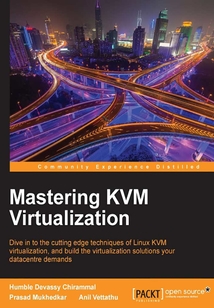目錄(129章)
倒序
- 封面
- 版權頁
- Credits
- About the Authors
- About the Reviewers
- www.PacktPub.com
- eBooks discount offers and more
- Preface
- What this book covers
- What you need for this book
- Who this book for
- Conventions
- Reader feedback
- Customer support
- Chapter 1. Understanding Linux Virtualization
- What is virtualization?
- Why should I use Linux virtualization?
- Types of virtualization
- Operating system virtualization/partitioning
- Hardware assisted virtualization
- Introducing VMM/hypervisor
- Open source virtualization projects
- What Linux virtualization offers you in the cloud
- Summary
- Chapter 2. KVM Internals
- Getting acquainted with libvirt and its implementation
- Internal workings of libvirt
- Time to think more about QEMU
- KVM in action
- Anonymous inodes and file structures
- Execution flow of vCPU
- Summary
- Chapter 3. Setting Up Standalone KVM Virtualization
- Getting acquainted with libvirt
- Hardware configuration examples
- Summary
- Chapter 4. Getting Started with libvirt and Creating Your First Virtual Machines
- Introducing virt-manager
- Creating virtual machines using the Virtual Machine Manager
- Introducing virt-install
- Automated virtual machine deployment
- Summary
- Chapter 5. Network and Storage
- Virtual networking
- Virtual networking using libvirt
- MacVTap
- PCI passthrough
- It's all about storage!
- Summary
- Chapter 6. Virtual Machine Lifecycle Management
- QEMU guest agent
- Virtual video cards and graphics
- VM migration
- Shared storage
- Enabling lockd
- Live or online migration
- Summary
- Chapter 7. Templates and Snapshots
- Introducing virtual machine templates
- Working with templates
- Deploying virtual machines from a template
- Deploying VMs using the clone provisioning method
- Deploying VMs using the thin provisioning method
- Snapshots
- Summary
- Chapter 8. Kimchi – An HTML5-Based Management Tool for KVM/libvirt
- Libvirt Web API
- Introduction to the Kimchi project
- Setting up Kimchi server
- Managing KVM virtualization infrastructure using kimchi WebUI
- Creating virtual machines through Kimchi WebUI
- Managing virtual machine through android phones
- Summary
- Chapter 9. Software-Defined Networking for KVM Virtualization
- Introducing Software Defined Networking
- Introducing Open vSwitch
- Integrating KVM VMs and OVS
- VLANs with Open vSwitch
- Applying traffic rate limiting
- Overlay networks
- Configuring Open vSwitch tunnels with VxLan
- Network port mirroring
- Managing Open vSwitch using the OpenDaylight SDN controller
- Basic Open vSwitch troubleshooting
- Summary
- Chapter 10. Installing and Configuring the Virtual Datacenter Using oVirt
- Introducing oVirt
- Installing the oVirt engine
- Summary
- Chapter 11. Starting Your First Virtual Machine in oVirt
- Getting acquainted with oVirt data center and cluster
- Creating storage domains
- Creating logical networks
- Creating and starting a virtual machine
- What next?
- Summary
- Chapter 12. Deploying OpenStack Private Cloud backed by KVM Virtualization
- OpenStack architecture
- OpenStack deployment
- Launching First Instance
- Troubleshooting the virtualization layer of OpenStack
- Accessing the instance configuration database
- QEMU Monitor Protocol
- Summary
- Chapter 13. Performance Tuning and Best Practices in KVM
- VirtIO
- CPU tuning
- Working with memory
- Getting acquainted with Kernel Same Page merging
- Tuning CPU and memory with NUMA
- Disk and block I/O tuning
- Networking tuning in KVM
- KVM guest time-keeping best practices
- Summary
- Chapter 14. V2V and P2V Migration Tools
- Introducing the virt-v2v utility
- How does virt-v2v work?
- VMware guest conversion
- Xen guest conversion
- Converting standalone KVM guests to an oVirt Virtualization platform and the OpenStack cloud
- Troubleshooting virt-v2v related issues
- Physical system to virtual conversion
- Can we convert any physical computers to virtual using virt-v2v?
- Converting virtual machines from unsupported virtualization platforms
- Summary
- Appendix A. Converting a Virtual Machine into a Hypervisor
- Introducing nested KVM
- How to enable nested KVM?
- Index 更新時間:2021-07-14 10:28:05
推薦閱讀
- 蘋果電腦玩全攻略 OS X 10.8 Mountain Lion
- 精解Windows8
- 循序漸進學Docker
- 嵌入式Linux驅動程序和系統開發實例精講
- 嵌入式Linux應用開發菜鳥進階
- 8051軟核處理器設計實戰
- 注冊表應用完全DIY
- Kali Linux高級滲透測試
- Windows 7實戰從入門到精通
- Linux操作系統
- Linux軟件管理平臺設計與實現
- 大規模分布式系統架構與設計實戰
- 應急指揮信息系統設計
- Windows 8完全自學手冊
- Windows7系統維護百寶箱
- Windows PE權威指南
- 數字系統設計與VHDL
- 從零開始學Windows 7
- Linux應用大全 服務器架設
- Windows XP操作系統5日通
- 深入理解嵌入式Linux設備驅動程序
- UG NX 4.0基礎培訓標準教程
- 大規模分布式存儲系統:原理解析與架構實戰
- Windows CE大排檔
- 輕松學家庭電腦應用
- Linux從初學到精通
- 系統安裝與重裝從入門到精通
- 循序漸進Linux(第2版) 基礎知識 服務器搭建 系統管理 性能調優 虛擬化與集群應用
- 詳解微軟Windows Azure云計算平臺
- MPEG-4/H.264視頻編解碼工程實踐


